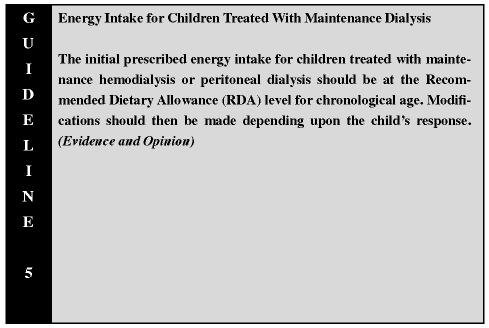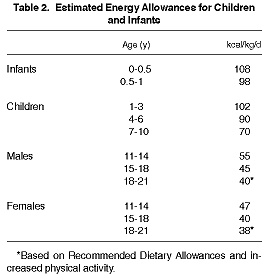

The Recommended Dietary Allowance (RDA) for energy intake in children33 is a guide based on extrapolated data (Table 2). These allowances have been designed so that children who receive that quantity of calories are highly unlikely to be calorie deficient. RDAs are meant to be applied to children as a group, rather than to the individual child, and therefore include a wide margin of safety. The American Academy of Pediatrics' Committee on Nutrition states that RDAs cannot be used as a measure of nutritional adequacy in children.34

There is no consistent evidence that daily energy intake for children treated with MD should exceed the RDA for age, at least initially. Children who demonstrate energy malnutrition, however, will require "catch-up" energy supplementation to achieve the RDA or higher. The Pediatric Nutrition Handbook of the American Academy of Pediatrics suggests a formula for such energy supplementation that is based on the child's weight age.34 There are no data to support this approach in children with CRF, and it is recommended that such supplementation be based on the child's chronological age and adjusted according to his or her response.
The calories derived from the dialysate glucose concentration should be included to the total dietary calorie intake in those patients treated with peritoneal dialysis. The peritoneal dialysate glucose absorption will increase the total calorie intake by 7 to 10 kcal/kg.35,36 Energy recommendations based on height age should be used as the basis for energy intake goals only if the patient does not gain weight appropriately with consistent caloric intake at the RDA for chronological age.
Energy supplementation exceeding the RDA for age has been administered to stable children treated with dialysis, but there are no data that demonstrate a consistent improvement in growth velocity. Assessment of growth has been routinely utilized as the outcome for energy supplementation in the published studies.37,38 In the absence of malnutrition, energy supplementation has demonstrated no other benefits in outcomes such as increased albumin levels, decreased morbidity, or decreased mortality. Attention to adequate amounts of non-protein calories is important for protein-sparing effects. A retrospective analysis of 31 children treated with dialysis (16 HD and 15 peritoneal dialysis), using multiple linear regression analysis, demonstrated that the growth velocity standard deviation scores correlated positively with caloric intake and negatively with protein intake.39 The regressions suggested a greater impact for suboptimal calories than for excess protein. It is expected that on-going monitoring will result in adjustment of calorie levels upward or downward as necessary.
Energy requirements for children have also been established based on age and height and reported as kcal/cm/d.34 This measure was used in a small study of children treated with MHD,26 which suggests that height may be a better standard than age for practical reasons: because height does not fluctuate from dialysis to dialysis, it is independent of fluctuations in total body water and/or body fat; and, because children with advanced renal failure are often stunted, it may be more appropriate to compare such children with others of the same height age.35 Sufficient normative data are not available to support the use of a height standard for energy prescriptions.
Many events may necessitate the admission of a child on MD to the hospital. A clearly definable severity scale of illness in a child on MD is not available and neither is there a body of data concerning nutrition needs in such children. It is recognized that it is not always medically indicated or necessary to deliver full nutrition to a patient in the first few days of hospitalization. Accordingly, it is recommended that as soon as it is medically appropriate to initiate nutrition in a hospitalized child, the nutrition provided should at least equal that prescribed for the child when he or she is an outpatient.